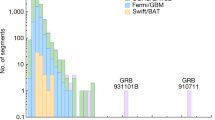Abstract
GAMMA-RAY bursts (GRBs) vary in duration from hundreds of seconds down to several milliseconds. Early studies1 suggested that bursts with durations of <100 ms form a distinct class, accounting for a few per cent of the total number of detected bursts, and there is some evidence2 for a break in the distribution of GRB durations at ∼600 ms, perhaps implying separate physical mechanisms for long and short bursts. Recently the estimated number of short GRBs has risen substantially. The shortest burst recorded so far is GRB820405, with duration ∼12ms (ref. 3), and the shortest spike within a burst, an unresolved feature with width <5 ms, was in GRB841215 (refs 4–7). GRB790305 had the shortest rise-time, 0.2ms. We report here that GRB910711, with apparently the shortest duration (∼8 ms) yet seen by the Burst and Transient Source Experiment (BATSE), has a time profile that shows significant submillisecond structure. The responses to this burst in the different BATSE detectors, from both direct and Earth-scattered γ-rays, show that the burst is both narrower and of higher energy than is indicated by a light-curve summed over all detectors. We detected a narrow spike of duration 200 μs in the light curve; variations on this timescale have not previously been observed in GRBs, and their explanation should be a stringent test of any GRB theory.
This is a preview of subscription content, access via your institution
Access options
Subscribe to this journal
Receive 51 print issues and online access
$199.00 per year
only $3.90 per issue
Buy this article
- Purchase on Springer Link
- Instant access to full article PDF
Prices may be subject to local taxes which are calculated during checkout
Similar content being viewed by others
References
Mazets, E. P. et al. Astrophys. Space Sci. 80, 1–83 (1981).
Barat, C. et al. Astrophys. J. 285, 791–800 (1984).
Mazets, E. P. et al. Positron-Electron Pairs in Astrophysics (eds Burns, M. L., Harding, A. K. & Ramaty, R.) 36–53 (Am. Inst. Phys., New York, 1983).
Laros, J. G. et al. Nature 318, 448–449 (1985).
Klebesadel, R. W. et al. IEEE Trans. Geosci. Remote Sens. GE-18, 76–80 (1980).
Anderson, K. A. et al. IEEE Trans. Geosci. Elect. GE-16, 157–159 (1978).
Fishman, G. J. et al. Proc. Gamma Ray Observatory Science Workshop, (ed. Johnson, W. N.) 39–50 (Greenbelt, MD: NASA/GSFC, 1989).
Harding, A. K. Phys. Rep. 206, 327–391 (1991).
Chernenko, A. M. & Mitrofanov, I. G. Gamma Ray Bursts, Proc. Los Alamos Workshop on Gamma Ray Bursts, Taos, 1990 (eds Ho, C., Epstein, R. I. & Fenimore, E. E.) 55–61 (Cambridge Univ. Press, 1992).
Mitrofanov, I. G. Astrophys. Space Sci. 155, 141–143 (1989).
Narayan, R., et al. Center for Astrophysics Preprint No. 3396 (1992).
Author information
Authors and Affiliations
Rights and permissions
About this article
Cite this article
Bhat, P., Fishman, G., Meegan, C. et al. Evidence for sub-millisecond structure in a γ-ray burst. Nature 359, 217–218 (1992). https://doi.org/10.1038/359217a0
Received:
Accepted:
Issue Date:
DOI: https://doi.org/10.1038/359217a0
This article is cited by
-
Rapid spectral variability of a giant flare from a magnetar in NGC 253
Nature (2021)
-
Line-of-shower trigger method to lower energy threshold for GRB detection using LHAASO-WCDA
Radiation Detection Technology and Methods (2021)
-
Neutron star mergers and how to study them
Living Reviews in Relativity (2020)
-
Ten years of AGILE: the mission and scientific highlights
Rendiconti Lincei. Scienze Fisiche e Naturali (2019)
-
Short duration gamma ray bursts
Pramana (2004)
Comments
By submitting a comment you agree to abide by our Terms and Community Guidelines. If you find something abusive or that does not comply with our terms or guidelines please flag it as inappropriate.



